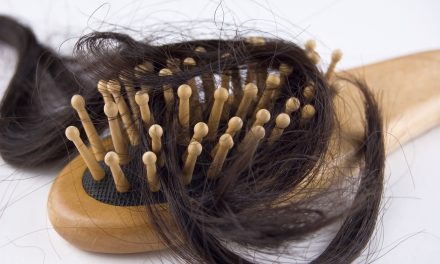Hair loss has puzzled scientists and researchers for generations, leading to extensive studies of its genetic origins. Recent genetic mapping research shows that hair loss stems from multiple inherited genes working together, rather than a single gene passed down from parents.
Scientists have identified several genes linked to hair loss patterns, with the APCDD1 gene pathway playing a key role in how hair grows and falls out. The way these genes interact creates a complex picture of why some people lose their hair while others keep a full head of hair throughout their lives.
Genetic factors combine with environmental influences to determine when and how hair loss occurs. This interaction helps explain why family members might experience different patterns of hair loss despite sharing similar genes.
Key Takeaways
- Multiple inherited genes work together to cause hair loss instead of a single gene
- Environmental factors interact with genes to influence the timing and pattern of hair loss
- Scientists have identified specific gene pathways that control hair growth and loss
The Basics of Hair Loss and Genetics
Hair loss has strong genetic roots that can be passed down through families. Genetic factors affect hair growth cycles and determine how hair follicles respond to hormones like androgens.
Scientists have identified several genes that play key roles in hair growth and loss patterns. These genes control important factors like:
- Hair follicle development
- Hair growth cycle length
- Hormone sensitivity
- Hair structure and strength
Specific mutations in steroid metabolism genes can increase the risk of early balding. When these genes don’t work properly, they can cause hair follicles to become more sensitive to hormones that trigger hair loss.
The inheritance pattern for hair loss is complex. A person may inherit multiple genetic variations from both parents that influence their likelihood of experiencing hair loss.
Research on hair follicle development shows that genetic factors work together with hormones and other biological processes to control hair growth. This explains why hair loss patterns can vary significantly among family members.
Some people carry hair loss genes but may never experience significant hair loss. Environmental factors and lifestyle choices can also impact how these genes express themselves.
The Role of Heredity in Hair Loss
Pattern hair loss has strong genetic links that pass through family lines. Scientists have found specific genes that control hair growth and loss patterns.
Inheriting Hair Loss Genes
The MC1R gene plays a key role in hair characteristics and loss patterns. When parents carry hair loss genes, they can pass these traits to their children.
Different ethnic groups show varying patterns of genetic hair loss. Men and women can both inherit hair loss genes from either parent.
Female pattern hair loss shares genetic origins with male pattern baldness. Multiple genes work together to influence hair growth cycles.
Dominant and Recessive Gene Influence
Hair loss genes can be either dominant or recessive. Dominant genes show their effects even if only one parent passes them on.
Recessive genes need copies from both parents to cause hair loss. This explains why some people experience hair loss while their siblings do not.
Research shows that genetic background affects how strongly these genes express themselves. Environmental factors can trigger or suppress genetic hair loss traits.
The timing and pattern of hair loss often match what previous generations experienced. This helps doctors predict future hair loss patterns in younger family members.
Genetic Predisposition and Hair Follicle Biology
The hair follicle contains complex biological pathways that control hair growth and loss. These pathways depend on specific genes passed down through families.
Scientists have found multiple genes linked to hair disorders and hair loss patterns. Some genes affect how the hair follicle forms, while others influence its growth cycle.
Hair follicles go through phases of growth, rest, and shedding. Genetic factors can affect how long each phase lasts and how the follicle responds to hormones.
Key Genetic Factors:
- Hormone receptor genes
- Growth regulation genes
- Hair structure genes
- Immune system genes
Research shows that hair follicle development starts during embryo growth. The genes active during this time help determine future hair characteristics and potential hair loss patterns.
Some people inherit genes that make their hair follicles more sensitive to hormones like DHT. This sensitivity often leads to pattern hair loss in both men and women.
Hair pigmentation genes also play a role. These genes control melanin production and can affect how the hair follicle functions throughout life.
The Significance of Androgenetic Alopecia
Androgenetic alopecia affects millions of people worldwide as the most common type of progressive hair loss. The condition results from a complex interaction between hormones and genetic factors.
Understanding Androgens’ Role
Androgens, particularly dihydrotestosterone (DHT), play a crucial role in hair loss patterns. These hormones bind to specific receptors in hair follicles, triggering miniaturization.
Research shows that affected hair follicles become increasingly sensitive to androgens over time. This sensitivity leads to shorter growth phases and thinner hair strands.
The process typically follows distinct patterns:
- Gradual recession of the hairline
- Thinning at the crown
- Progressive reduction in hair diameter
Genetic Markers of Androgenetic Alopecia
Studies of family histories reveal strong genetic patterns in hair loss inheritance. Sons with balding fathers have a higher risk of developing the condition.
Multiple genes influence androgenetic alopecia. The androgen receptor (AR) gene on the X chromosome plays a particularly important role.
Research has identified specific genetic variations that increase susceptibility to hair loss. These markers help explain why the condition appears more frequently in certain families.
Recent genetic studies have revealed:
- Polygenic inheritance patterns
- Variable expression of related genes
- Age-dependent activation of genetic factors
Exploring Polygenic Inheritance Patterns in Baldness
Male pattern baldness stems from complex interactions between many different genes. Recent genetic studies have revealed that hair loss risk involves multiple genetic factors working together rather than a single gene.
Multiple Genes and Their Combined Effect
Scientists have identified 71 different genetic regions that influence male pattern baldness. These genes explain about 38% of the risk of developing this condition.
The genetic signals affect various biological systems involved in hair growth and loss. Some genes control hormone responses, while others regulate hair follicle development and function.
Modern genetic analysis shows that each person carries a unique combination of these hair loss risk genes. Someone might inherit high-risk variants from both parents, increasing their chances of early baldness.
Scientists use polygenic risk scores to measure the combined effect of these genetic variants. This helps predict an individual’s likelihood of developing significant hair loss.
Recent research continues to uncover new genetic variations linked to hair loss. Each discovery adds to our knowledge of how these genes work together to influence baldness patterns.
Epigenetics and Hair Loss: Beyond Genetics
Hair aging and loss involve more than just the genes we inherit from our parents. Epigenetic factors can turn genes on or off without changing the DNA sequence itself.
These epigenetic changes happen throughout our lives based on various factors like lifestyle, environment, and aging. They can affect how our hair growth genes work even if the genes themselves haven’t changed.
Recent research shows that epigenetic modifications influence hair follicle development and maintenance. These changes can impact how well hair grows and when it starts to thin.
Key epigenetic factors affecting hair health:
- Diet and nutrition
- Stress levels
- Environmental exposures
- Hormonal changes
- Aging processes
Scientists have discovered that understanding these epigenetic factors could lead to new treatments for hair loss. This research goes beyond traditional genetic studies to examine how lifestyle and environmental factors influence hair growth patterns.
The good news is that some epigenetic changes can be reversed, unlike genetic mutations. This means certain types of hair loss might be prevented or treated by targeting these epigenetic modifications.
Gender Differences in Hair Loss Genes
Hair loss genes affect men and women differently, with distinct patterns and ages of onset. The genetic factors behind male and female pattern hair loss involve variations in hormone receptors and enzymes that process androgens.
Male Pattern Baldness Genetics
Androgen receptor gene variations play a key role in male pattern baldness. These genes control how sensitive hair follicles are to male hormones like testosterone.
Men with specific genetic markers often start losing hair in their 20s or 30s. The pattern typically begins at the temples and crown of the head.
Two main types of genes affect male hair loss:
- Androgen receptor genes
- 5-alpha reductase genes that convert testosterone to DHT
Female Hair Loss and Genetic Factors
Female pattern hair loss has a different genetic basis than male baldness. Women’s hair loss tends to show up as overall thinning rather than complete baldness.
The genetic links to female hair loss are more complex. Multiple genes interact with hormones and aging factors to cause thinning hair.
Women with a family history of hair loss face higher risks. The condition often becomes noticeable after menopause when hormone levels change.
Key genetic factors in female pattern hair loss:
- Hormone receptor genes
- Enzyme-related genes
- Genes Affecting Hair Growth Cycles
Recent Advances in Hair Loss Gene Research
Scientists have made major progress in finding genes linked to hair loss. New genetic studies have found several genes that affect how hair grows and stays healthy.
One key finding shows that WNT signaling genes play a crucial role in controlling hair growth patterns. These genes help decide if hair follicles grow normally or start to shrink.
Research teams have identified genetic markers that can predict who might lose their hair early in life. This helps doctors spot hair loss risks before visible symptoms appear.
Studies of hair disorders have revealed new treatment targets. Scientists now know more about which proteins and molecules to focus on when making hair loss medicines.
Genetic testing has become more precise at finding hair loss risks. Labs can now check multiple genes at once to give a fuller picture of someone’s likelihood of keeping their hair.
Key Research Breakthroughs:
- Discovery of new hair growth control genes
- Better understanding of follicle development
- Improved genetic testing methods
- New targets for hair loss treatments
Recent research shows that hair follicles need specific genetic signals to work properly. When these signals go wrong, it can lead to different types of hair loss.
Genetic Testing for Hair Loss: Prospects and Limitations
Genetic testing offers new possibilities for predicting and managing hair loss patterns. DNA analysis can reveal specific gene variants linked to different types of hair loss, though the technology still has important limitations.
Predictive Genetic Testing for Baldness
Genetic studies of androgenetic alopecia show strong links between family history and hair loss patterns. Testing can identify several key genes that influence baldness risk.
DNA tests look for variations in these important genes:
- Androgen receptor (AR) gene
- 5-alpha reductase gene
- EDA2R gene
The accuracy of these tests varies. While they can indicate risk levels, they cannot predict the exact age of onset or pattern of hair loss. Recent advances in genetic research have improved testing reliability, but environmental factors still play a major role.
Ethical Considerations of Genetic Testing
Privacy concerns remain a key issue with genetic testing for hair loss. Test results could potentially affect insurance coverage or lead to discrimination.
People need to consider these factors before genetic testing:
- Who will have access to the results
- How the information might be used
- Whether they want to know their risk levels
Family history information can impact relatives who share genetic traits. This raises questions about whether to inform family members of test results.
Insurance companies might use genetic information to adjust coverage or rates. Clear regulations protect against discrimination, but concerns persist about data security and privacy.
Therapeutic Interventions Targeting Hair Loss Genes
Scientists have made significant progress in developing treatments that target genes linked to hair loss. Pharmacological interventions can now selectively target specific melanins, genes, and proteins in hair follicles.
Gene therapy shows promise as an emerging treatment option. Researchers have successfully targeted therapeutic genes to hair follicles, opening new possibilities for treating genetic hair loss conditions.
Stem cell therapy represents another cutting-edge approach. Stem cell treatments work by activating growth factors and specific cellular pathways that control hair growth and regeneration.
Researchers are exploring treatments that target estrogen-related genes in hair follicles. These estrogen-targeted therapies can influence the expression of multiple genes involved in hair growth and maintenance.
Current therapeutic approaches include:
- Gene therapy targeting hair follicle cells
- Stem cell treatments
- Growth factor stimulation
- Hormone pathway modification
- Protein-targeted medications
The success rates of these treatments vary, and many are still in the development stages. Scientists continue to identify new genetic targets and refine existing therapies to improve their effectiveness.
Lifestyle and Environmental Factors Affecting Hair Loss Genes
While genes play a key role in hair loss, daily habits and environmental exposures can influence how these genes are expressed. Research shows that certain lifestyle factors can impact genetic hair loss patterns.
Mitigating Genetic Hair Loss Through Lifestyle
A balanced diet rich in protein, vitamins, and minerals helps maintain healthy hair growth, even in people with a genetic predisposition to hair loss. Proper nutrition and lifestyle modifications can slow down hereditary hair thinning.
Key Lifestyle Factors:
- Stress management through regular exercise and meditation
- Adequate sleep (7-9 hours nightly)
- Protection from UV radiation and harsh environmental elements
- Gentle hair care practices
Avoiding harsh chemical treatments and excessive heat styling can protect hair follicles from additional damage. This becomes especially important for individuals with genetic susceptibility to hair loss.
Regular scalp massage increases blood flow to hair follicles, which may help counteract genetic hair loss patterns. Combined with proper nutrition, these practices support optimal hair growth conditions.
Frequently Asked Questions
Genes play a major role in hair loss patterns and timing, with specific variants linked to male and female pattern baldness. Environmental factors, lifestyle choices, and medical conditions also affect how these genetic predispositions manifest.
Can genetic hair loss be prevented or slowed down?
While genetic hair loss cannot be completely prevented, early intervention with FDA-approved treatments like minoxidil and finasteride can slow progression.
Clinical studies of hair loss show that combining multiple treatment approaches works best for managing genetically-driven hair loss.
Maintaining good scalp health and avoiding harsh chemical treatments helps protect existing hair.
At what age does genetic hair loss typically begin?
Pattern hair loss can start as early as the late teens or early 20s in men with strong genetic predisposition.
Women typically notice genetic thinning in their 40s or 50s, though it can begin earlier.
The timing of hair loss onset varies significantly based on individual genetic factors and hormonal changes.
Is the tendency for hair loss inherited from one’s mother, father, or both parents?
Hair loss inheritance patterns involve multiple genes from both parents.
The old myth about inheriting baldness only from the maternal grandfather is incorrect.
Research shows complex genetic origins with contributions from both maternal and paternal DNA.
What non-genetic factors can contribute to hair loss?
Stress, poor nutrition, and certain medications can trigger or worsen hair loss.
Medical conditions like thyroid disorders and autoimmune diseases affect hair growth cycles.
Harsh styling practices, chemical treatments, and environmental damage impact hair health.
Is there an evolutionary explanation for why humans experience hair loss?
Male pattern baldness may have evolved as a signal of social maturity and status in human societies.
The genes linked to hair loss also play important roles in hormone regulation and development.
How can one determine if their hair loss is due to genetics?
The pattern and progression of hair loss provide key clues – genetic loss typically follows predictable patterns.
Family history assessment and professional evaluation by a dermatologist can confirm genetic causes.
Hair loss that occurs suddenly or in patches is more likely due to other factors than genetics.
Conclusion
Hair loss genes arise from complex genetic inheritance patterns passed down through generations. Both maternal and paternal DNA contribute to these traits.
Scientists have identified multiple genes implicated in hair growth, with discoveries emerging through ongoing research. The WNT signaling pathway plays a key role in hair follicle development and maintenance.
Genetic testing now allows people to learn about their predisposition to hair loss conditions. This knowledge helps medical professionals develop targeted treatments for specific genetic variants.
Research continues to uncover new connections between genes and hair growth patterns. Each discovery brings scientists closer to developing more effective treatments for genetic hair loss disorders.
The future holds promise for gene therapy and personalized medicine approaches. These advances may one day allow doctors to modify or repair faulty hair loss genes at their source.
















